In the summer of 2020, FIDE and the ECU joined forces to take a survey on what Chess in Schools (CiS) looks like in the world. The information gathered would inform the next step, that of suggesting an operational, marketing, and financial plan for FIDE for Chess in Schools for 2021-2025. The group working with the survey, people from FIDE, ECU, and the Armenian Institute, chose the broader definition of Chess in Schools: chess in a school environment.
All 190 federations under the umbrella of FIDE were contacted, as well as major CiS – organisations, and asked to complete a survey of 17 questions in Survey Monkey to get a statistical foundation. The next steps were to structure the statistics, make a report, select especially interesting countries and projects, and make interviews with those involved to get a deeper understanding. This final report will be presented in a seminar that includes the supervisory group of the project as well as members of FIDE EDU and ECU EDU. After that, the survey report will be given to a group responsible for creating the strategic plan for FIDE EDU for 2021-2025.
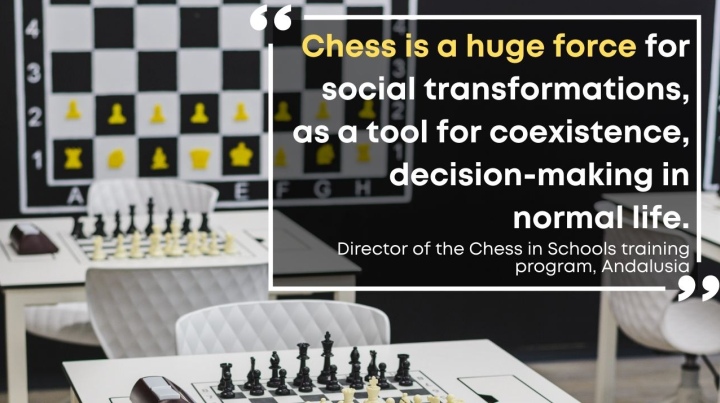
This survey is likely the largest of its kind with 196 respondents, out of which were 135 federations, 39 CiS-organisations, and 22 private and public schools.
According to the survey, currently, there are 25,600,000 children participating in chess activities in a school environment. Of that number, 15,000,000 of them are children in India, 5,000,000 in China, and 5,600,000 from the rest of the world.
There are 92,550 schoolteachers and 145,690 instructors from outside the school providing chess instruction and programming around the world.
Overview of Responses
Number of Responses | 196 |
Number of Countries Responding | 152 |
Number of Federations/Countries Not Responding | 42 |
Number of Students Participating in Some Form of Chess Activity in a School Setting | About 25,373,339* |
Number of Countries with More Than 10000 Children Participating in Some Form of Chess Activity in a School Setting | 37 |
Number of Teachers | About 92,550 |
Number of Chess Coaches | About 145,690 |
Number of Countries Using Software | 98 |
Number of Countries with Qualifications for Teaching Chess in Schools | 78 |
Number of Countries That Used Official Data to Estimate the Facts They Provided in This Survey | 44 |
Number of Countries That Used Data from Research to Estimate the Facts They Provided in This Survey | 20 |
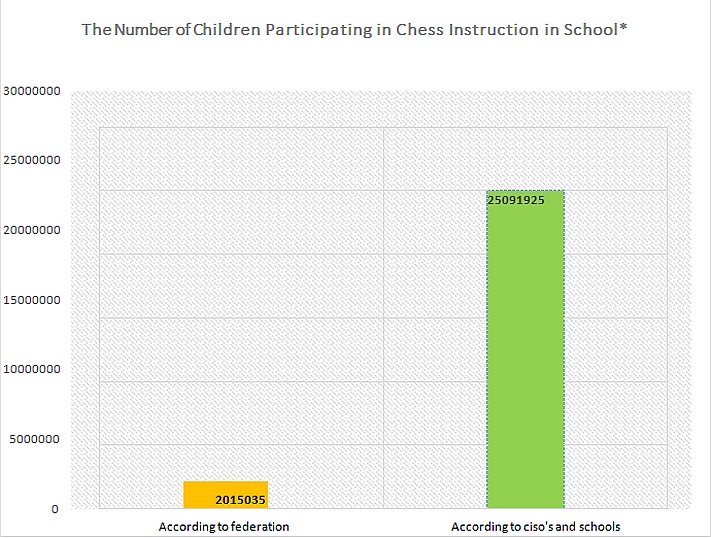
* We should take into account that the vast majority of children participating in chess instruction in school are from India and China. 15,000,000 according to the survey response from India. 5,000,000 according to the survey response from China.
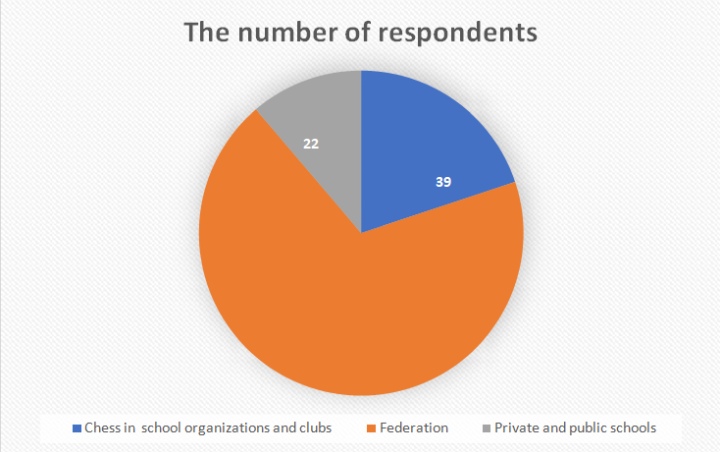
It is important to note that the data collected is not precise from the standpoint of a researcher conducting a rigorous scientific study. Responders to the survey often offered their best guesses as to the state of chess in education in their country. Many of these estimates are likely to be underestimated while a few may be inflated. Still, the survey does represent a good first glimpse of the worldwide state of chess in schools.

Based on the data obtained, the respondents consider FIDE as the main sponsor for the development of the chess education model.
For Institutionalized (centralized with support and recognition from the government, often compulsory, with a national curriculum) and Diversity (decentralized with a variety of ways in how chess is used and how chess instruction is given ) models, FIDE’s potential for helping with the development of chess education is considered in the area of the development of support for teachers’ training.
This help may include the following:
- Provision of feedback to teachers
- Identification of teachers’ needs and suggestions, for example, organizing a forum for the exchange of ideas between schoolteachers
- Promotion of outstanding teachers of the world and their involvement in the process of introducing educational chess
- Introduction of preschool chess education
- Identification of reference schools with good chess teaching practices and disseminating their experience
- Distribution of training materials, advertising brochures, videos in different languages
Respondents pointed out the need to work with national governments to spread chess education and sponsor teacher training as well as to build bridges between educational and sport chess.
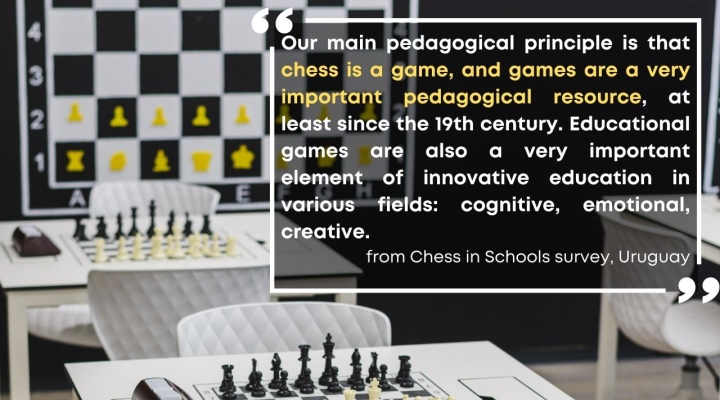
The issue of the necessity for certification was perceived ambiguously by different respondents. The issue of certification, in the opinion of some respondents, should be assigned to the national Ministries of Education.
In some cases, there was a proposal of the necessity for additional interaction between FIDE and local state bodies in order to avoid conflicts that could hinder the development of chess education (Singapore). The Diversity Model was characterized by an emphasis on material assistance, for example, in sponsoring technical means to conduct online classes with outstanding teachers (India). Helping disadvantaged Asian and African countries, as well as a desire for help in transferring educational excellence, was noted in China.
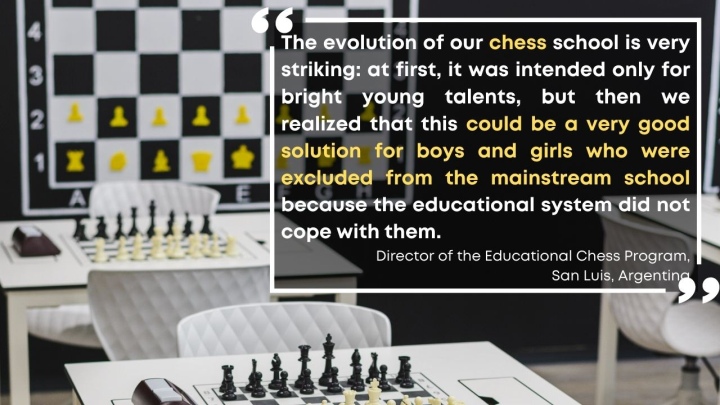
For the Less Institutionalized Model (the countries with either underdeveloped chess in schools’ movements struggling with little or no funding or no federation involvement or centralization), the following suggestions were more relevant:
- Lobbying the government to recognize chess as a school subject (including at the European Union level)
- Accreditation of training courses
- Development of publicly available training programs
- Provision of training courses online
- Help in popularizing chess, advertising for teachers, schools, politicians
- Holding a conference with UNESCO for politicians, educators’ organizations and others
- Financial support
Model of Chess Education in Countries That Participated in Follow-up Interviews
Institutionalized Model | Diversity Model | Less Institutionalized Model* |
Andalusia (Spain) | Buenos Aires, (Argentina) | Finland |
Aragon (Spain) | San Luis (Argentina) | France |
Armenia | Andorra | England |
Catalonia (Spain) | India | USA |
Santa Fe (Argentina) | China | Zambia |
Uruguay | Singapore |
|
| Iceland |
|
| Sweden |
|







